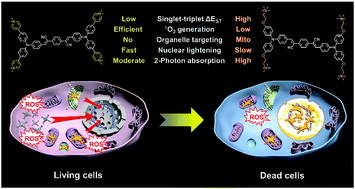Multicationic AIEgens for unimolecular photodynamic theranostics and two-photon fluorescence bioimaging†
Abstract
Photodynamic theranostics integrating synchronous photodynamic therapy and real-time monitoring of therapeutic efficacy has attracted great interest in clinical cancer management. Recently, a series of cationic molecules have been reported as self-reporting photosensitizers for unimolecular photodynamic theranostics. However, the design rationality and mechanisms for such multifunctional photosensitizers are not well understood and need further exploration. In this work, we have designed and synthesized three multicationic AIEgen photosensitizers with similar core structures, but which are end-capped with pyridinium groups (BPCI and TPCI) or quaternary ammonium groups (TPCB), respectively. The tetra-pyridinium-tethered TPCI exhibits superior efficiency in reactive oxygen species generation and dead cell identification compared to both bis-pyridinium-tethered BPCI and tetra-ammonium-tethered TPCB. The structure–activity relationship of all three AIEgens has been studied in detail, which provides great insights into designing the new generation of photosensitizers for photodynamic theranostics. Strikingly, all the multicationic AIEgens have large two-photon absorption cross-sections, and TPCI can effectively kill Caenorhabditis elegans upon white light irradiation and differentiate the dead nematodes from the living ones through the redistribution of its two-photon fluorescence, demonstrating great potential in two-photon fluorescence imaging-guided photodynamic theranostics.

- This article is part of the themed collection: 2020 Materials Chemistry Frontiers HOT articles


 Please wait while we load your content...
Please wait while we load your content...